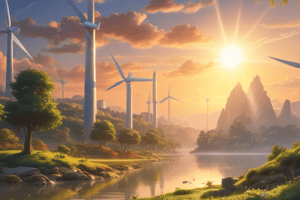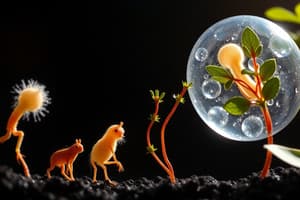Podcast
Questions and Answers
Who discovered chloroplasts as the site of starch production in plants?
Who discovered chloroplasts as the site of starch production in plants?
- Sachs (correct)
- Melvin Calvin
- Andrew Benson
- No one discovered this
Which scientist's contributions to photosynthesis were crucial but did not receive the same recognition as his colleague who won a Nobel Prize?
Which scientist's contributions to photosynthesis were crucial but did not receive the same recognition as his colleague who won a Nobel Prize?
- Sachs
- Andrew Benson (correct)
- Melvin Calvin
- No one fits this description
What did Andrew Benson discover that revolutionized the understanding of how plants use carbon dioxide to produce sugars?
What did Andrew Benson discover that revolutionized the understanding of how plants use carbon dioxide to produce sugars?
- The Calvin-Benson cycle (correct)
- The manipulation of photosynthesis by commercial growers
- The importance of sunlight in starch production
- The site of starch production in plants
In commercial agriculture, what innovative methods are used to manipulate factors for higher yields?
In commercial agriculture, what innovative methods are used to manipulate factors for higher yields?
What are scientists working on replicating in labs to potentially create clean and limitless energy sources?
What are scientists working on replicating in labs to potentially create clean and limitless energy sources?
What are the main requirements for photosynthesis to occur?
What are the main requirements for photosynthesis to occur?
Who conducted an experiment with a willow tree to understand plant growth?
Who conducted an experiment with a willow tree to understand plant growth?
Which scientist discovered that plants release oxygen in sunlight?
Which scientist discovered that plants release oxygen in sunlight?
What was the contribution of Julius Sachs to plant biology?
What was the contribution of Julius Sachs to plant biology?
Where did Julius von Sachs become the head of a botanical institute at a young age?
Where did Julius von Sachs become the head of a botanical institute at a young age?
Flashcards are hidden until you start studying
Study Notes
- Plants need water, sunlight, and carbon dioxide for photosynthesis to produce food and oxygen.
- Photosynthesis is a complex process that has been studied for over 400 years.
- Jan Baptist van Helmont conducted an experiment with a willow tree to understand plant growth, concluding that plants grow by drinking water, not eating soil.
- In the 17th century, there was little understanding of the connection between light and plant growth.
- Jan Ingenhousz, in the late 18th century, discovered that plants release oxygen in sunlight through experiments with leaves in water.
- Ingenhousz proved that sunlight, not heat, triggers the release of gas (oxygen) from leaves during photosynthesis.
- Julius Sachs, born in 1832, made significant advancements in botany and plant research in the 19th century, furthering our understanding of photosynthesis.- Julius von Sachs, a botanist, collected plant specimens and conducted thousands of experiments to understand plant physiology.
- After facing personal tragedy, Sachs dropped out of school but later worked at the University of Prague where he conducted experiments rigorously.
- Sachs' experiments led to the publication of the "Textbook of Experimental Plant Physiology," a seminal work in plant biology.
- He became the head of Europe's top botanical institute in Wurzburg at just 36 years old, leading significant research in botany.
- Sachs' experiments revealed the importance of sunlight in the production of starch in plants, a breakthrough in understanding photosynthesis.
- He discovered chloroplasts as the site of starch production in plants, a major advancement in plant biology.
- The Calvin-Benson cycle, discovered by Andrew Benson, revolutionized the understanding of how plants use carbon dioxide to produce sugars.
- Benson's contributions to photosynthesis were crucial, although he did not receive recognition like his colleague Melvin Calvin who won a Nobel Prize.
- Plants adapt to varying environmental conditions for photosynthesis, with some innovative methods used in commercial agriculture to manipulate factors like light and carbon dioxide levels for higher yields.
- Greenhouses in countries like the Netherlands and the UK leverage artificial lighting and increased carbon dioxide levels to enhance plant growth and productivity.- Increasing carbon dioxide levels can lead to sweeter tomatoes and higher yields.
- Commercial growers have mastered manipulating photosynthesis to improve crop production.
- Plants rely on photosynthesis to convert light energy into fuel for growth.
- Scientists are working on replicating photosynthesis in labs to potentially create clean and limitless energy sources.
- While we understand the basic principles of photosynthesis, replicating it remains a challenge.
Studying That Suits You
Use AI to generate personalized quizzes and flashcards to suit your learning preferences.




